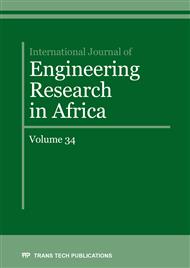[1]
Sodhi M.M.S., Son B. -G. and Tang C.S. (2012), Perspectives on Supply Chain Risk Management, Production and Operations Management, Vol. 21, n°1, pp.1-13.
DOI: 10.1111/j.1937-5956.2011.01251.x
Google Scholar
[2]
Tang O. and Nurmaya Musa S. (2011), Identifying risk issues and research advancements in supply chain risk management, International Journal of Production Economics, Vol. 133, n°1, pp.25-34.
DOI: 10.1016/j.ijpe.2010.06.013
Google Scholar
[3]
Lavastre O., Gunasekaran A. and Spalanzani A. (2014).
Google Scholar
[4]
Christopher, M. and Peck, H. (2004), Building the resilient supply chain, International Journal of Logistics Management, Vol. 15 No. 2, pp.1-13.
Google Scholar
[5]
Jüttner U. (2005), Supply Chain Risk Management: Understanding the Business Requirements from a Practitioner Perspective, The International Journal of Logistics Management, Vol. 16, n°1, pp.120-141.
DOI: 10.1108/09574090510617385
Google Scholar
[6]
Craighead C.W., Blackhurst J., Rungtusanatham M.J. and Handfield R. (2007), The severity of supply chain disruptions: Design characteristics and mitigation capabilities, Decision Sciences, Vol. 38, n°1, pp.131-156.
DOI: 10.1111/j.1540-5915.2007.00151.x
Google Scholar
[7]
Wieland A. and Wallenburg C.M. (2012), Dealing with supply chain risks: Linking risk management practices and strategies to performance, International Journal of Physical Distribution & Logistics Management, Vol. 42, n°10, pp.887-905.
DOI: 10.1108/09600031211281411
Google Scholar
[8]
Lavastre O., Gunasekaran A. and Spalanzani A. (2012), Supply Chain Risk Management in French Companies, Decision Support Systems, Vol. 52, n°4, pp.828-838.
DOI: 10.1016/j.dss.2011.11.017
Google Scholar
[9]
Evrard-Samuel K. (2013), Concevoir des supply chains résilientes : simple évolution du management des risques ou mutation stratégique majeure ?, Logistique & Management, Vol. 21, n°2, pp.33-45.
DOI: 10.1080/12507970.2013.11517015
Google Scholar
[10]
Manuj I. and Mentzer J.T. (2008), Global supply chain risk management, Journal of Business Logistics, Vol. 29, n°1, pp.133-155.
DOI: 10.1002/j.2158-1592.2008.tb00072.x
Google Scholar
[11]
Fassio G. (2006), Risques et performance d'un réseau industriel d'approvisionnement, essais d'identification et d'analyse des secteurs automobile, aéronautique et construction navale, Logistique & Management, Vol. 14, n°1, pp.19-32.
DOI: 10.1080/12507970.2006.11516851
Google Scholar
[12]
Tang C.S. (2006), Perspectives in supply chain risk management, International Journal of Production Economics, Vol. 103, n°2, pp.451-488.
DOI: 10.1016/j.ijpe.2005.12.006
Google Scholar
[13]
Tang S.C. and Tomlin B. (2008), The power of flexibility for mitigating supply chain risks, International Journal of Production Economics, Vol. 116, n°1, pp.12-27.
DOI: 10.1016/j.ijpe.2008.07.008
Google Scholar
[14]
Ouabouch, L. & Lavastre, O., 2015. Vulnérabilité, risque et performance en Supply Chain Management : Cas de l'industrie agroalimentaire au Maroc. Logistique & Management, 23(1), p.71–89.
DOI: 10.1080/12507970.2015.11665673
Google Scholar
[15]
Wagner S.M. and Bode C. (2008), An Empirical Examination Of Supply Chain Performance Along Several Dimensions of Risk, Journal of Business Logistics, Vol. 29, n°1, pp.307-325.
DOI: 10.1002/j.2158-1592.2008.tb00081.x
Google Scholar
[16]
Zsidisin G.A. (2003), A Grounded Definition of Supply Risk, Journal of Purchasing and Supply Management, Vol. 9, n°5-6, pp.217-224.
DOI: 10.1016/j.pursup.2003.07.002
Google Scholar
[17]
Tachizawa E.M. and Gimenez C. (2010), Supply flexibility strategies in Spanish firms: Results from a survey, International Journal of Production Economics, Vol. 124, n°1, pp.214-224.
DOI: 10.1016/j.ijpe.2009.11.020
Google Scholar
[18]
Zsidisin G.A. and Ellram L.M. (2003), An Agency Theory Investigation of Supply Risk Management, Journal of Supply Chain Management: A Global Review of Purchasing & Supply, Vol. 39, n°3, pp.15-27.
DOI: 10.1111/j.1745-493x.2003.tb00156.x
Google Scholar
[19]
Wagner, S.M., Bode, C., Koziol, P., 2009. Supplier default dependencies: empirical evidence from the automotive industry. European Journal of Operational Research 199 (1), 150–161.
DOI: 10.1016/j.ejor.2008.11.012
Google Scholar
[20]
Germain R. and Dröge C. (2008), Supply chain variability, organizational structure, and performance: The moderating effect of demand unpredictability, Journal of Operations Management, Vol. 26, n°5, pp.557-570.
DOI: 10.1016/j.jom.2007.10.002
Google Scholar
[21]
Van der Vorst J. G. and Beulens A.J. (2002), Identifying sources of uncertainty to generate supply chain redesign strategies, International Journal of Physical Distribution & Logistics Management, Vol. 32, n°6, pp.409-430.
DOI: 10.1108/09600030210437951
Google Scholar
[22]
Zsidisin G.A., Wagner S.M., Melnyk S.A. and Ragatz G.L. (2008).
Google Scholar


